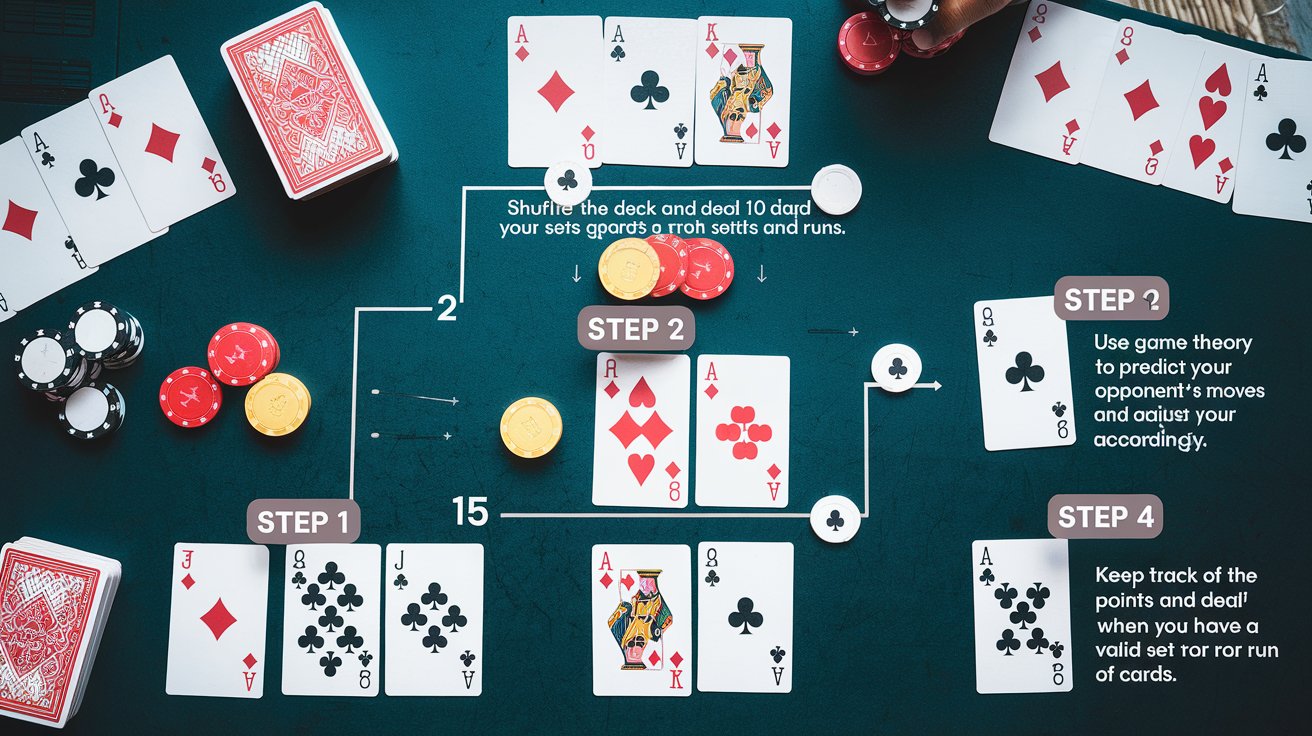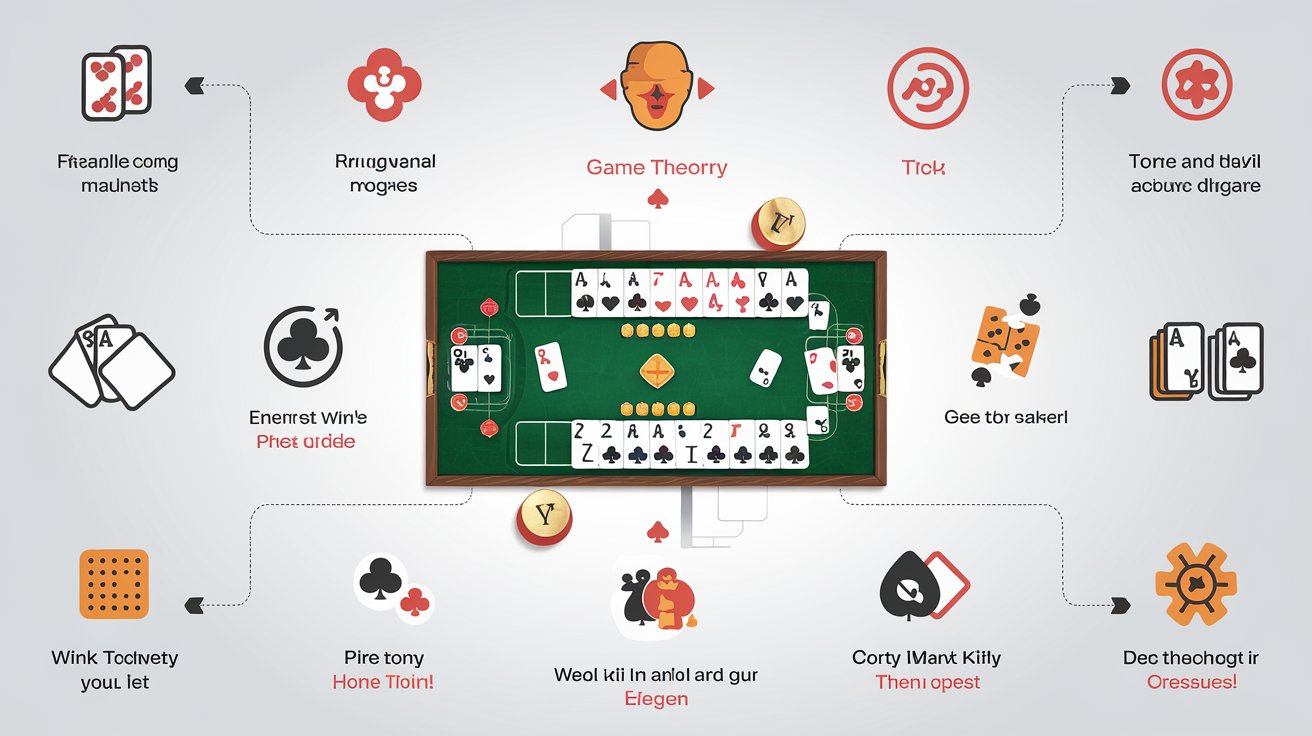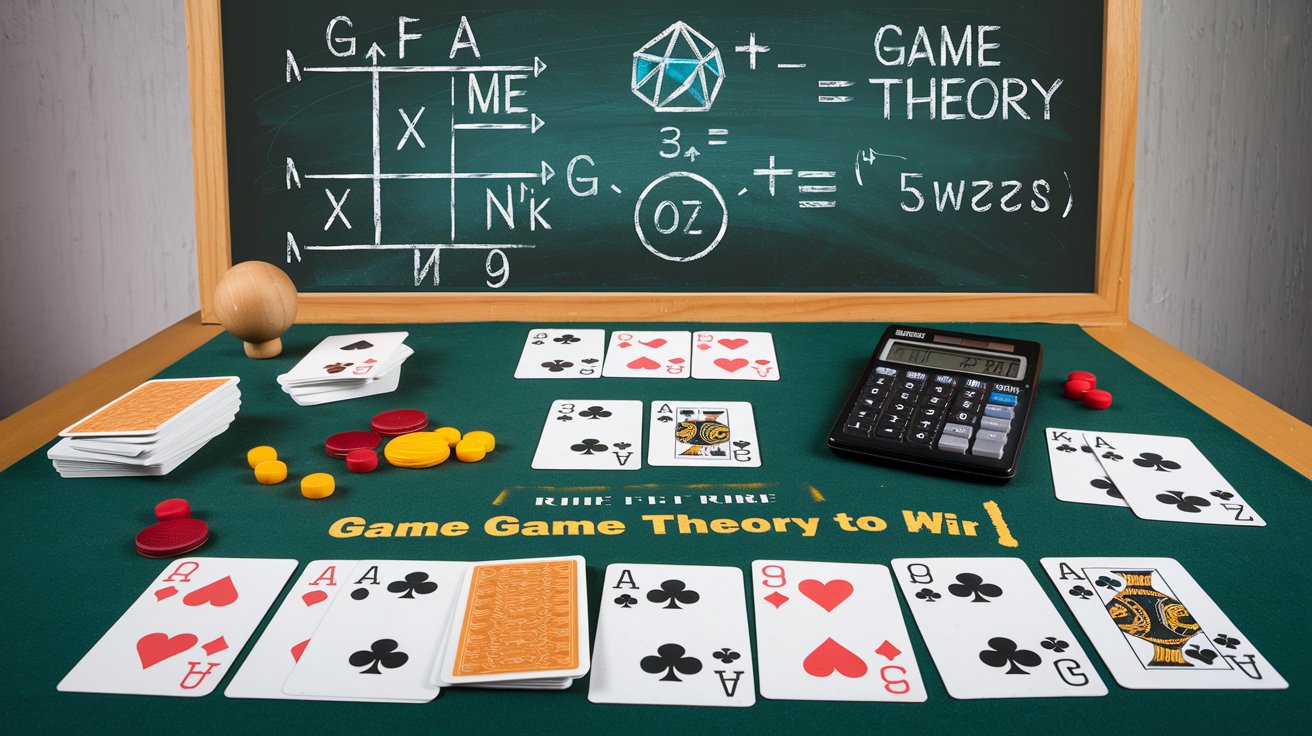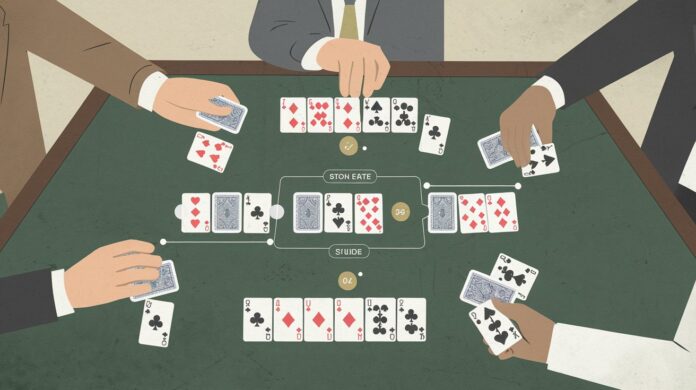Rummy isn’t just a game of luck—it’s a sophisticated test of strategic thinking where the principles of game theory can dramatically improve your results. While many players rely on intuition or basic tactics, those who understand the mathematical and strategic frameworks of game theory gain a significant competitive edge.
Game theory—the study of mathematical models of strategic interaction among rational decision-makers—provides powerful tools for analyzing and optimizing decisions in competitive scenarios. When applied to Rummy, these concepts transform random card play into calculated strategic maneuvers that consistently lead to victory.
In this comprehensive guide, we’ll explore how to apply game theory concepts to Rummy, breaking down complex strategic principles into practical techniques you can implement immediately. Whether you’re playing casual games with friends or competing in high-stakes tournaments, these game theory approaches will revolutionize your Rummy performance.
Understanding Game Theory Foundations for Rummy

The Strategic Nature of Rummy
Rummy represents what game theorists call an “imperfect information game” with these key characteristics:
- Sequential decision-making: Players take turns, with each decision affecting future possibilities
- Hidden information: Players cannot see opponents’ cards
- Partial observability: Some information becomes visible through discards and melds
- Mixed strategy requirements: Optimal play often requires strategic randomization
Understanding these fundamental elements helps frame how game theory applies to your decision-making process throughout the game.
Nash Equilibrium in Rummy Contexts
Named after mathematician John Nash, Nash Equilibrium describes a state where no player can benefit by changing only their own strategy while others maintain theirs. In Rummy, this manifests in several ways:
- Draw strategy equilibrium: The balanced approach to choosing between the discard pile and the stock pile
- Melding equilibrium: The optimal timing for revealing melds versus keeping them concealed
- Discard selection equilibrium: The strategic choice of which cards to discard based on risk-reward calculations
When all players adopt equilibrium strategies, the game becomes a sophisticated battle of small advantages gained through superior information processing and pattern recognition.
Strategic Decision Trees in Rummy

Mapping Decision Pathways
Game theory encourages mapping potential decision trees to optimize choices:
- Identify decision points: Recognize key moments where strategic choices must be made
- Enumerate options: List all possible actions at each decision point
- Calculate outcomes: Estimate the potential results of each action
- Backward induction: Work backward from potential end states to determine optimal present actions
For example, when deciding whether to pick from the discard pile, a decision tree might include:
- Option A: Take known card from discard pile
- Outcome A1: Complete a meld immediately
- Outcome A2: Move closer to completing a meld
- Outcome A3: Reveal strategic information to opponents
- Option B: Draw from the stock pile
- Outcome B1: Draw needed card (with probability calculation)
- Outcome B2: Draw unhelpful card
- Outcome B3: Maintain information advantage
By systematically analyzing these paths, you can make decisions with greater strategic depth.
Expected Value Calculations
At the heart of game theory decision-making is the concept of expected value (EV):
Expected Value = (Probability of Outcome 1 × Value of Outcome 1) + (Probability of Outcome 2 × Value of Outcome 2) + ...
In Rummy, this applies to numerous decisions:
- Drawing decisions: Calculate the EV of drawing from the discard pile versus the stock pile
- Melding decisions: Determine the EV of melding now versus waiting for more optimal combinations
- Discard selections: Compute the EV of different discard options based on the risk of helping opponents
For instance, if taking a visible 8 of hearts completes a sequence worth 5 points (100% certainty), while drawing from the stock has a 15% chance of completing a different sequence worth 20 points, the EV comparison would be:
- Discard EV: 5 points (100% × 5)
- Stock EV: 3 points (15% × 20)
In this case, the higher expected value lies with taking the known card.
Opponent Modeling and Exploitation

Strategic Profiling
Game theory emphasizes understanding your opponents’ decision patterns:
- Style classification: Categorize opponents as aggressive, conservative, mathematical, or intuitive players
- Tendency mapping: Identify recurring patterns in opponents’ drawing, melding, and discarding decisions
- Adaptation tracking: Monitor how opponents adjust their strategies throughout the game
Comprehensive opponent modeling allows you to predict actions and exploit suboptimal tendencies.
Exploitative Strategies
Once you’ve modeled opponents’ strategies, game theory provides frameworks for exploitation:
- Counter-strategy development: Implement targeted approaches that specifically exploit identified weaknesses
- Information manipulation: Control what information you reveal to shape opponents’ perceptions and decisions
- Pattern establishment and breaking: Create recognizable patterns in your play, then strategically deviate to catch opponents off-guard
For example, if an opponent consistently avoids picking from the discard pile when certain card types appear, you can strategically discard these cards when you need to dispose of potentially useful cards.
Level-k Thinking
Game theorists describe strategic depth using “level-k” thinking:
- Level-0: Non-strategic play based on immediate needs
- Level-1: Strategic play that considers opponents’ likely moves
- Level-2: Advanced strategy that considers what opponents think about your strategy
- Level-3+: Higher-order thinking that incorporates multiple levels of strategic anticipation
In Rummy, this might manifest as:
- Level-1 thinking: “My opponent needs hearts, so I won’t discard hearts.”
- Level-2 thinking: “My opponent knows I need spades, so they’ll avoid discarding spades.”
- Level-3 thinking: “My opponent thinks I need spades, so I’ll actually shift my strategy to collecting diamonds while they waste effort protecting spades.”
Mastering these levels of strategic depth creates significant advantages against less sophisticated players.
Mixed Strategies and Strategic Randomization
The Importance of Unpredictability
Game theory emphasizes that in competitive situations, predictability is exploitable. Implementing mixed strategies—intentionally randomizing between different actions—is often optimal:
- Drawing randomization: Vary your choices between the discard pile and stock pile, even in similar situations
- Melding variation: Randomize when you choose to reveal melds versus keeping them concealed
- Discard unpredictability: Vary your discard selections to prevent opponents from identifying patterns
This unpredictability prevents opponents from accurately modeling your strategy and developing effective counter-strategies.
Optimal Randomization Ratios
Game theory provides mathematical frameworks for determining optimal randomization ratios—how frequently you should choose each option in a mixed strategy:
- Minimax solutions: Minimize the maximum damage opponents can inflict through their best responses
- Indifference principle: Randomize in proportions that make opponents indifferent between their counter-strategies
- Regret minimization: Adjust randomization ratios to minimize regret about missed opportunities
For instance, if discarding face cards is generally safe but occasionally costly, while discarding number cards is moderately risky, game theory might suggest a randomization ratio of 70% face cards and 30% number cards to optimize your overall risk-reward profile.
Information Management and Signaling
Strategic Information Control
Game theory views information as a strategic resource to be carefully managed:
- Information concealment: Hide your strategic intentions through misleading or ambiguous plays
- Selective revelation: Strategically reveal information to influence opponents’ decisions
- Signal manipulation: Send false signals about your hand composition or strategic direction
Mastering information management creates significant advantages in the partially observable environment of Rummy.
Credible Signaling
For signals to influence opponents’ behavior, they must be credible:
- Costly signals: Actions that would be irrational unless backed by specific card holdings
- Consistent signals: Patterns of play that align with the hand composition you want opponents to believe you have
- Timing-based signals: Strategic timing of actions to suggest particular intentions
For example, discarding an 8 immediately after picking up a 7 sends a credible signal that you’re not collecting sequences around those numbers, but only if discarding the 8 would otherwise be suboptimal.
Bluffing and Counter-Bluffing
The game theory concept of bluffing applies strategically in Rummy:
- Strategic misdirection: Showing interest in cards you don’t actually need
- False set indication: Creating the impression you’re building different melds than your actual targets
- Defensive bluffing: Deterring opponents from discarding certain cards by falsely signaling interest
Just as importantly, recognizing when opponents are bluffing allows you to avoid being manipulated by their information management strategies.
Dynamic Adaptation and Strategic Evolution
Progressive Game Theory
As games progress, optimal strategies evolve based on new information and changing circumstances:
- Phase-based adaptation: Adjust strategies for early, middle, and endgame phases
- Information-dependent shifts: Modify approaches as new information becomes available
- Position-based adjustments: Adapt strategy based on relative position in points or proximity to winning
Static strategies are rarely optimal throughout an entire game—dynamic adaptation based on game theory principles maximizes results across changing conditions.
Strategic Inflection Points
Game theorists identify critical moments where strategic approaches should shift significantly:
- Dead card identification: When certain cards are confirmed unavailable, restructuring hand strategy
- Meld threshold moments: When enough melds are completed to justify shifting to aggressive declaration strategy
- Opponent strategy revelations: When opponents clearly reveal their strategic direction
Recognizing these inflection points and responding appropriately creates substantial advantages over players who maintain fixed strategies.
Practical Application: Game Theory in Action
Early Game Strategy
Apply these game theory principles in the opening phase:
- Information gathering focus: Prioritize collecting data about opponents’ strategies while revealing minimal information about your own
- Flexibility premium: Maintain multiple potential melding pathways rather than committing early
- Mixed drawing strategy: Establish an unpredictable pattern of drawing from both the stock and discard piles
The early game establishes the strategic foundation and information asymmetry that you’ll leverage throughout the match.
Mid-Game Optimization
As the game progresses, shift to these game theory approaches:
- Bayesian strategy updates: Continuously revise probability estimates and strategic choices based on new information
- Commitment timing: Strategically transition from flexible play to committed melding based on expected value calculations
- Opponent exploitation implementation: Begin actively exploiting the opponent tendencies you’ve identified
The mid-game often determines the eventual winner through superior information processing and strategic adaptation.
Endgame Theory
In the closing phase, apply these high-leverage game theory concepts:
- Endgame database approach: Similar to chess endgames, develop optimal strategies for common endgame scenarios
- Minimizing opponent options: Structure play to limit opponents’ viable strategic choices
- Declaration timing optimization: Calculate precisely when declaring provides maximum expected value
Mastering endgame theory often makes the difference between consistent winners and runners-up.
Case Studies: Game Theory Principles in Practice
Case Study 1: The Discard Dilemma
Consider this scenario: You hold 7-8-9 of hearts and 7-8 of diamonds. The discard pile shows a 6 of hearts. Should you take it?
Game theory analysis:
- Taking the 6 creates a sequence but reveals strategic information
- Not taking it conceals your interest in hearts but delays completing a meld
- Opponent modeling suggests your primary opponent likely needs heart sequences
The game theory solution involves calculating the expected value of information concealment versus immediate melding, then making a decision based on specific game context and opponent tendencies.
Case Study 2: Strategic Melding Timing
You’ve completed two sequences but haven’t melded them. When should you reveal them?
Game theory considerations:
- Early melding reduces point liability but reveals strategic direction
- Delayed melding maintains information advantage but increases risk
- Mixed strategy would involve occasionally melding early and occasionally waiting
The optimal approach depends on calculating the value of information versus the risk of point accumulation, adjusted for specific opponent exploitation opportunities.
Case Study 3: Defensive Discarding
You hold K♠, 10♥, 3♦, and 4♣, none of which contribute to your melding strategy. Which should you discard?
Game theory analysis requires:
- Assessing which cards are likely useful to opponents based on observed drawing patterns
- Calculating the risk-weighted expected cost of each discard
- Potentially randomizing between the least risky options to maintain unpredictability
This exemplifies how game theory transforms even mundane decisions into strategic opportunities.
Conclusion: The Game Theory Mindset
Applying game theory to Rummy transforms it from a casual card game into a sophisticated strategic battleground. By understanding and implementing concepts like decision trees, expected value calculations, opponent modeling, mixed strategies, and information management, you develop a systematic approach that consistently outperforms intuition-based play.
The most powerful aspect of the game theory approach is its comprehensiveness—it provides frameworks for every decision throughout the game, creating an integrated strategic system rather than isolated tactics. This systematic approach leads to more consistent results and continuous improvement.
Remember that mastering game theory in Rummy doesn’t require complex mathematics during play. Instead, focus on internalizing the core principles through study and practice until they become second nature. Over time, you’ll develop intuition that naturally aligns with game theory optimization.
As you implement these strategies, you’ll notice not just improved results but a deeper appreciation for the strategic richness of Rummy. Your opponents may be playing a card game, but you’ll be engaging in a sophisticated strategic contest where every decision reflects the elegant mathematics of game theory.
Shuffle up, apply these principles, and transform your Rummy play from chance-dependent to strategically optimized. Your consistent winning results will speak for themselves.

Zareb Saleh is a journalist at Gulf Today and a ghostwriter for Gameoholic, specializing in gaming, technology, and digital culture. With a keen eye for industry trends, he delivers insightful stories that engage and inform readers.




